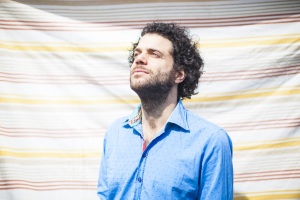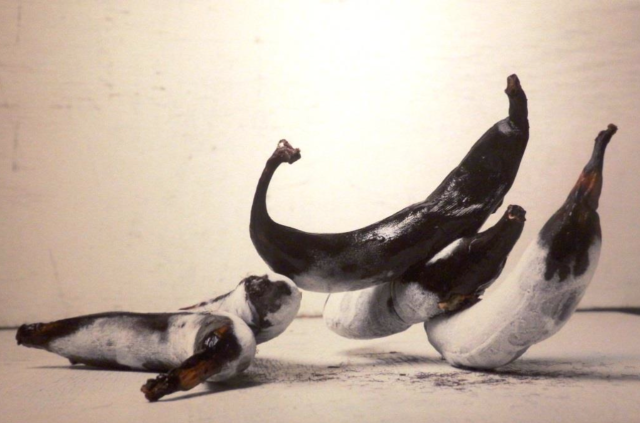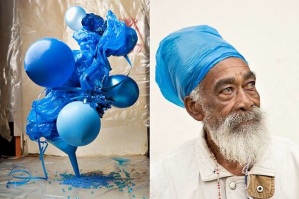Lorenzo Vitturi

Dalston Anatomy
1 AUG – 19 OCT 2014
“I wanted to capture Ridley Road market’s edgy dynamic”
The Venice-born photographer Lorenzo Vitturi, arrived in London eight years ago. He graduated in photography and design in Rome in 2004 then went on to secure a creative apprenticeship with Fabrica, the famous Benetton-funded communication research centre in Treviso. Afterwards he worked as a film set painter for an italian director of erotic films and most recently on the 2005 Disney remake of Fellini’s Casanova.
 Vitturi’s exhibition is placed on the fifth floor of the Photographers’ Gallery.
The show feels very different from the standard photography exhibitions I have attended before. The way the collection of artworks has been arranged is unusual but at the same time interesting. The photographs have not been framed; most of them are printed on wood and displayed using rough fabrics or wooden boxes as background. The effect leads the viewer to recall market stalls and the makeshift structures. They are meticulously designed with a remarkable sense of colour.
Vitturi’s exhibition is placed on the fifth floor of the Photographers’ Gallery.
The show feels very different from the standard photography exhibitions I have attended before. The way the collection of artworks has been arranged is unusual but at the same time interesting. The photographs have not been framed; most of them are printed on wood and displayed using rough fabrics or wooden boxes as background. The effect leads the viewer to recall market stalls and the makeshift structures. They are meticulously designed with a remarkable sense of colour.
 For the Photographers’ Gallery, Vitturi has presented a mix of images, collages and sculptures created with materials and objects found amongst discarded matters of the market. A poem written on a carpet by Sam Berkson, aka Angry Sam (an Hackney based poet performing since 2002) plays the language of the market through fragments of overheard conversations.
The idea behind this unusual installation has been revealed by Vitturi himself during a recent interview in which he explains that the poem should be a means for everyone who doesn’t know about the market, to capture the essence of it reading just those few lines.
In many of the photographs, portraits of local people are located next to images of market produce; some have their faces overlaid with shapes and colours matching those objects seen next to them.
The coloured chalk used by Vitturi to cover some of the physiognomy in the images is itself sold from little baskets on a stall on Ridley Road.
Later, he found out that it used as a painkiller in west Africa for women who are pregnant, making the connection in the imagery deeper.
The most interesting aspect of Vitturi’s photographs is the magic hidden in the detail, the secrets concealed behind the unrevealed faces, and the idea that every picture has its own story.
For the Photographers’ Gallery, Vitturi has presented a mix of images, collages and sculptures created with materials and objects found amongst discarded matters of the market. A poem written on a carpet by Sam Berkson, aka Angry Sam (an Hackney based poet performing since 2002) plays the language of the market through fragments of overheard conversations.
The idea behind this unusual installation has been revealed by Vitturi himself during a recent interview in which he explains that the poem should be a means for everyone who doesn’t know about the market, to capture the essence of it reading just those few lines.
In many of the photographs, portraits of local people are located next to images of market produce; some have their faces overlaid with shapes and colours matching those objects seen next to them.
The coloured chalk used by Vitturi to cover some of the physiognomy in the images is itself sold from little baskets on a stall on Ridley Road.
Later, he found out that it used as a painkiller in west Africa for women who are pregnant, making the connection in the imagery deeper.
The most interesting aspect of Vitturi’s photographs is the magic hidden in the detail, the secrets concealed behind the unrevealed faces, and the idea that every picture has its own story.

“I am interested in the fragility of things and what you can do with that as an artist”

Personally, I think this photograph that could easily be mistaken for a painting, is the perfect example of what Lorenzo Vitturi wants to communicate with his status above.
These bananas have undergone the time passing by, the skin has changed colour and texture, with the oil they naturally release making them look shiny and smooth.
The mouldy wall used as background and the hair left on the table, once again are the details that an inquisitive eye would expect for from Vitturi’s unusual still life.
This particular shot drew my attention as a “naturally” black and white picture in a triumph of colours. As quick as the bananas fall victim of the inexorable march of the time, the market with its stunning colours and vividly multicultural working-class is rapidly disappearing under the tidal wave of gentrification.
Dalston Anatomy became on of the most acclaimed photography books of 2013; a set of pictures that are unusual and different from traditional street photography but yet evoking the energy of the street in their own unique way.
Here is a short video showing few of the images in Vitturi’s book, hope you will enjoy it.
 Vitturi’s exhibition is placed on the fifth floor of the Photographers’ Gallery.
The show feels very different from the standard photography exhibitions I have attended before. The way the collection of artworks has been arranged is unusual but at the same time interesting. The photographs have not been framed; most of them are printed on wood and displayed using rough fabrics or wooden boxes as background. The effect leads the viewer to recall market stalls and the makeshift structures. They are meticulously designed with a remarkable sense of colour.
Vitturi’s exhibition is placed on the fifth floor of the Photographers’ Gallery.
The show feels very different from the standard photography exhibitions I have attended before. The way the collection of artworks has been arranged is unusual but at the same time interesting. The photographs have not been framed; most of them are printed on wood and displayed using rough fabrics or wooden boxes as background. The effect leads the viewer to recall market stalls and the makeshift structures. They are meticulously designed with a remarkable sense of colour.
 For the Photographers’ Gallery, Vitturi has presented a mix of images, collages and sculptures created with materials and objects found amongst discarded matters of the market. A poem written on a carpet by Sam Berkson, aka Angry Sam (an Hackney based poet performing since 2002) plays the language of the market through fragments of overheard conversations.
The idea behind this unusual installation has been revealed by Vitturi himself during a recent interview in which he explains that the poem should be a means for everyone who doesn’t know about the market, to capture the essence of it reading just those few lines.
In many of the photographs, portraits of local people are located next to images of market produce; some have their faces overlaid with shapes and colours matching those objects seen next to them.
The coloured chalk used by Vitturi to cover some of the physiognomy in the images is itself sold from little baskets on a stall on Ridley Road.
Later, he found out that it used as a painkiller in west Africa for women who are pregnant, making the connection in the imagery deeper.
The most interesting aspect of Vitturi’s photographs is the magic hidden in the detail, the secrets concealed behind the unrevealed faces, and the idea that every picture has its own story.
For the Photographers’ Gallery, Vitturi has presented a mix of images, collages and sculptures created with materials and objects found amongst discarded matters of the market. A poem written on a carpet by Sam Berkson, aka Angry Sam (an Hackney based poet performing since 2002) plays the language of the market through fragments of overheard conversations.
The idea behind this unusual installation has been revealed by Vitturi himself during a recent interview in which he explains that the poem should be a means for everyone who doesn’t know about the market, to capture the essence of it reading just those few lines.
In many of the photographs, portraits of local people are located next to images of market produce; some have their faces overlaid with shapes and colours matching those objects seen next to them.
The coloured chalk used by Vitturi to cover some of the physiognomy in the images is itself sold from little baskets on a stall on Ridley Road.
Later, he found out that it used as a painkiller in west Africa for women who are pregnant, making the connection in the imagery deeper.
The most interesting aspect of Vitturi’s photographs is the magic hidden in the detail, the secrets concealed behind the unrevealed faces, and the idea that every picture has its own story.






Recent Comments